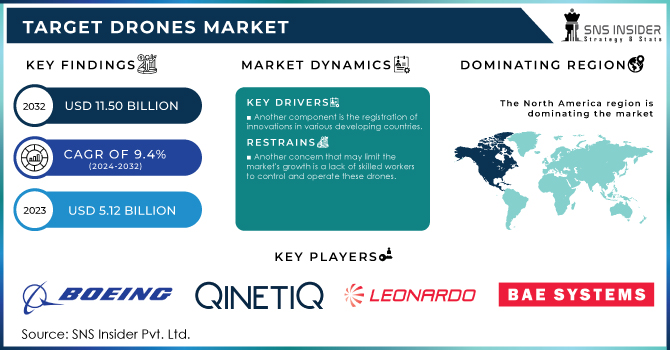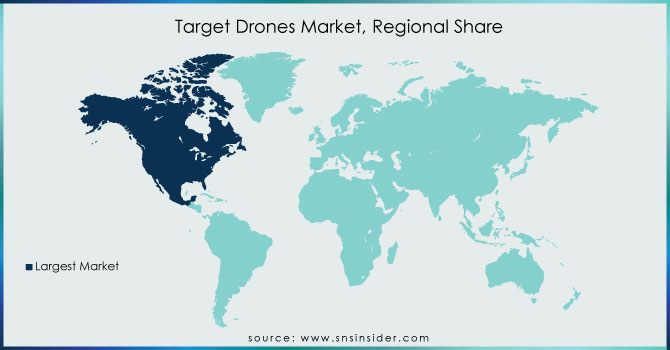Target Drones Market Report Scope & Overview:

To get more information on Target Drones Market - Request Free Sample Report
The Target Drones Market size was valued at USD 5.12 billion in 2023 and is expected to reach USD 11.50 billion by 2032 with a growing CAGR of 9.4% over the forecast period 2024-2032.
Targeted drones are a subset of remote control vehicles (UAV) used to test and evaluate weapons systems, to carry out combat missions and to train anti-aircraft personnel in real-life simulation. It provides reliability, efficiency, and efficiency of the cost of various weapons, training, roles, and thus, contributes to the increased preparation of wars between the defense forces in the country. The use of drones can vary in shape and size, but more importantly, the main components (battery, micro-motor, control, sensors) are basically the same.
As drones are made of smartphone components, investing in the last 10 years has led to a drop in drone prices and improved access for consumers and businesses. The use of drones can be considered as smartphones with the ability to fly or fly. Unlike many fin-tech developments such as big data, as well as payment innovations, the use of drones is an important combination of mobile hardware and internet access. Drones are like distributed sensors, intelligent and easy to generate data on them. They can serve as a platform for the various programs, applications, and business models. In fact, all drone mapping software, editing software, drone insurance policy, and human markets to find drone pilots are already in place.
MARKET DYNAMICS
KEY DRIVERS
-
Another component is the registration of innovations in various developing countries.
-
One of the primary factors driving the expansion of this market is the increased funding in the defence industry, which focuses on military training in emerging nations.
RESTRAINTS
-
Another concern that may limit the market's growth is a lack of skilled workers to control and operate these drones.
-
The operation of these drones is heavily reliant on the operators.
OPPORTUNITIES
-
Rising Defense System Deployment in Emerging Markets
-
Growing Defense Budgets of Major Economies
CHALLENGES
-
Short Endurance of Target Drones
-
Regulations frequently alter to fit the needs of current and future business uses.
THE IMPACT OF COVID-19
The corona-virus epidemic has wreaked havoc on the manufacturing, development, production, and logistics industries. Many restrictions were also implemented by the governments of many countries as a result of the COVID-19 issue. The Target Drones Market has been unaffected by the pandemic. Because these drones are used in the defence industry, and no country in the world will or is willing to jeopardize its external security, the government granted special licence to the manufacturers and operators of these drones to continue their job from their offices rather than their homes. As a result, this industry is operating at its typical pace, as it was prior to the epidemic.
The market for target drones has been divided based on end-use, mode of operation, engine type, Target, Fit, and geography. The target drones market has been divided into three categories based on end-use: aerial targets, maritime targets, and ground targets. During the forecast period, the aerial targets segment is expected to lead. The segment's expansion might be ascribed to the widespread use of these drones in military operations around the world to simulate hostile aircraft threats.
The market is divided into two segments based on fit: line fit and retrofit. Both line fit and retrofit are in high demand because they offer the variety and functionality that developing organizations want. In particular, the Retrofit model has emerged as the most preferred since, unlike the Line fit model, it allows the end-user to further change it even after purchase.
The market is divided into three segments: IC Engine, Turbojet, and Target Drones. IC engines are known for their high processing speeds, whilst Turbojet engines are noted for their tremendous power output. Both are experiencing rising demand in their respective markets. To make turbojet engine drones smarter than previously, IC engines can be incorporated. Turbojet engines are commonly utilized in big armed forces drones, whilst IC engines are used in navigation and small drones. The market is divided into four sections: aerial, ground, sea, and others. By 2028, the aerial target category is expected to lead the market. This comprises an unmanned aerial target drone, with arms forces controlling 80% of the market. These drones are powered by internal combustion, which is extremely cost-effective due to the use of movable parts.
KEY MARKET SEGMENTATION
By Mode of Operation
-
Autonomous
-
Remotely Piloted
By Target
-
Aerial Target
-
Ground Target
-
Marine Target
By End Use
-
Defense
-
Commercial
By Engine Type
-
IC Engine
-
Turbojet
-
Others
By Fit
-
Line fit
-
Retrofit
REGIONAL ANALYSIS
The Target Drones Market movement operates remarkably well in the 6 major regions of the world namely North America, Asia Pacific, Europe, Africa, South America and the Middle East. In each of these regions, the North American region will dominate the market and the reason for that is the increase in investment in defense training programs. Also, the budget allocated to the US government for targeted drones is very large. Also, the move was taken by the US government to convert old fighter jets into airborne aircraft aimed at assisting with the training and testing of arrows and to bring real-time threats to air combat operations. The Asia Pacific region will witness significant growth during the forecast period and the region's growth will be led by China and India. Another reason for the growth of this region is the lack of converting technology used in these drones available in Russia. The African and Middle Eastern region will experience moderate growth due to a lack of adequate infrastructure and skilled workers to operate in the region.

Need any customization research on Target Drones Market - Enquiry Now
REGIONAL COVERAGE:
-
North America
-
USA
-
Canada
-
Mexico
-
-
Europe
-
Germany
-
UK
-
France
-
Italy
-
Spain
-
The Netherlands
-
Rest of Europe
-
-
Asia-Pacific
-
Japan
-
south Korea
-
China
-
India
-
Australia
-
Rest of Asia-Pacific
-
-
The Middle East & Africa
-
Israel
-
UAE
-
South Africa
-
Rest of Middle East & Africa
-
-
Latin America
-
Brazil
-
Argentina
-
Rest of Latin America
-
KEY PLAYERS
The Major Players are Boeing Company, QinetiQ Group plc, Northrop Grumman Corporation, Kratos Defense & Security Solutions, Inc., Airbus Group, Lockheed Martin Corporation, Leonardo S.p.A., BSK Defense S.A., Air Affairs Australia Pty Ltd, Saab AB, AeroTargets International, LLC, L3 ASV, BAE Systems, Raytheon , General Dynamics Corporation and Other Players
| Report Attributes | Details |
|---|---|
| Market Size in 2023 | US$ 5.12 Billion |
| Market Size by 2032 | US$ 11.5 Billion |
| CAGR | CAGR of 9.4% From 2024 to 2032 |
| Base Year | 2023 |
| Forecast Period | 2024-2032 |
| Historical Data | 2020-2022 |
| Report Scope & Coverage | Market Size, Segments Analysis, Competitive Landscape, Regional Analysis, DROC & SWOT Analysis, Forecast Outlook |
| Key Segments | • By Mode of Operation (Autonomous and Remotely Piloted) • By Target (Aerial Target, Ground Target, and Marine Target) • By End Use (Defense and Commercial) • By Engine Type (IC Engine, Turbojet, Others) • By Fit (Line fit, Retrofit) |
| Regional Analysis/Coverage | North America (USA, Canada, Mexico), Europe (Germany, UK, France, Italy, Spain, Netherlands, Rest of Europe), Asia-Pacific (Japan, South Korea, China, India, Australia, Rest of Asia-Pacific), The Middle East & Africa (Israel, UAE, South Africa, Rest of Middle East & Africa), Latin America (Brazil, Argentina, Rest of Latin America) |
| Company Profiles | Boeing Company, QinetiQ Group plc, Northrop Grumman Corporation, Kratos Defense & Security Solutions, Inc., Airbus Group, Lockheed Martin Corporation, Leonardo S.p.A., BSK Defense S.A., Air Affairs Australia Pty Ltd, Saab AB, AeroTargets International, LLC, L3 ASV, BAE Systems, Raytheon , General Dynamics Corporation |
| DRIVERS | • Another component is the registration of innovations in various developing countries. • One of the primary factors driving the expansion of this market is the increased funding in the defence industry, which focuses on military training in emerging nations. |
| RESTRAINTS | • Another concern that may limit the market's growth is a lack of skilled workers to control and operate these drones. • The operation of these drones is heavily reliant on the operators. |

